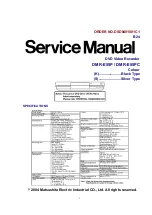
20-14 Maximum Reference/Feedb.
Range:
Function:
100.000
ProcessCtrlUnit
*
[par. 20-13 -
999999.999
ProcessCtrlUnit]
Enter the maximum
reference/feedback for
closed loop operation. The
setting determines the
highest value obtainable
by summing all reference
sources for closed loop
operation. The setting
determines 100% feedback
in open and closed loop
(total feedback range:
-200% to +200%).
NOTE
If operating with
set for Open Loop
[0],
3-03 Maximum Reference
must be used.
NOTE
The dynamics of the PID controller will depend on the value
set in this parameter. Please see also
Par. 20-13 and par. 20-14 also determine the feedback range
when using feedback for display readout with
set for Open Loop [0]. Same condition as above.
3.18.2 20-2* Feedback & Setpoint
This parameter group is used to determine how the
frequency converter’s PID Controller will use the three
possible feedback signals to control the output frequency of
the frequency converter. This group is also used to store the
three internal setpoint references.
20-20 Feedback Function
Option:
Function:
This parameter determines how the three
possible feedbacks will be used to control the
output frequency of the frequency converter.
[0] Sum
Sum
[0] sets up the PID Controller to use the sum
of Feedback 1, Feedback 2 and Feedback 3 as the
feedback.
NOTE
Any unused feedbacks must be set to
No
Function
in
,
, or
The sum of Setpoint 1 and any other references
that are enabled (see par. group 3-1*) will be used
as the PID Controller’s set-point reference.
[1] Difference
Difference
[1] sets up the PID controller to use the
difference between Feedback 1 and Feedback 2
20-20 Feedback Function
Option:
Function:
as the feedback. Feedback 3 will not be used with
this selection. Only Setpoint 1 will be used. The
sum of Setpoint 1 and any other references that
are enabled (see par. group 3-1*) will be used as
the PID controller’s set-point reference.
[2] Average
Average
[2] sets up the PID Controller to use the
average of Feedback 1, Feedback 2 and Feedback
3 as the feedback.
NOTE
Any unused feedbacks must be set to
No
Function
in
,
, or
. The sum of Setpoint 1 and any other
references that are enabled (see par. group
3-1*) will be used as the PID Controller’s set-
point reference.
[3]
*
Minimum
Minimum
[3] sets up the PID Controller to
compare Feedback 1, Feedback 2 and Feedback 3
and use the lowest value as the feedback.
NOTE
Any unused feedbacks must be set to
No
Function
in
,
, or
. Only setpoint 1 will be used. The
sum of Setpoint 1 and any other references
that are enabled (see par. group 3-1*) will be
used as the PID Controller’s setpoint
reference.
[4] Maximum
Maximum
[4] sets up the PID Controller to
compare Feedback 1, Feedback 2 and Feedback 3
and use the highest value as the feedback.
NOTE
Any unused feedbacks must be set to
No
Function
in
,
, or
.
Only Setpoint 1 will be used. The sum of Setpoint
1 and any other references that are enabled (see
par. group 3-1*) will be used as the PID
Controller’s setpoint reference.
[5] Multi
Setpoint
Min
Multi-setpoint minimum
[5] sets up the PID
Controller to calculate the difference between
Feedback 1 and Setpoint 1, Feedback 2 and
Setpoint 2, and Feedback 3 and Setpoint 3. It will
use the feedback/setpoint pair in which the
feedback is the farthest below its corresponding
setpoint reference. If all feedback signals are
above their corresponding setpoints, the PID
Controller will use the feedback/setpoint pair in
Parameter Description
VLT
®
HVAC Drive Programming Guide
MG.11.CB.02 - VLT
®
is a registered Danfoss trademark
125
3
3
















































